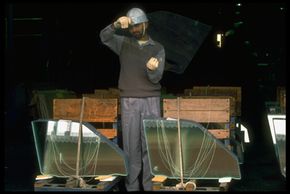Automakers began using laminated safety glass, also known as auto glass, for automobile windshields in 1927. To make laminated safety glass, the manufacturer sandwiches a thin layer of flexible clear plastic film called polyvinyl butyral (PVB) between two or more pieces of glass. The plastic film holds the glass in place when the glass breaks, helping to lessen injuries from flying glass. The film also can stretch, yet the glass still sticks to it. It is also quite difficult to penetrate laminated safety glass, compared to normal window pane glass. The "sandwich with some give" that laminated safety glass is made of also helps hold the occupants in a vehicle! Banks use a multiple-layer laminated glass to help stop bullets.
Laminated safety glass has two other additional benefits:
Advertisement
- It reduces transmission of high frequency sound.
- It blocks 97 percent of ultraviolet radiation.
Laminated safety glass is also used in:
- Thermometers for taking body temperature
- Cutting boards
- Greenhouse windows
- Shower enclosures
- Office partitions
Laminated safety glass resists falling out of its frame during an earthquake or a tornado.
Tempered safety glass is a single piece of glass that gets tempered using a process that heats, then quickly cools, the glass to harden it. The tempering process increases the strength of the glass to five to 10 times that of untempered glass. Tempered safety glass breaks differently than regular clear glass. When tempered safety glass is struck it does not break into sharp jagged pieces of shrapnel-like glass as normal window panes or mirrors do. Instead, it breaks into little pebble-like pieces, without sharp edges. It is used in the side and rear windows of automobiles. Eyewear uses tempered glass that has been tempered using a chemical process.
Tempered safety glass is also used in:
- Computer monitors
- Liquid crystal displays (LCDs)
- Skylights
- Refrigerator shelves
- Oven doors
- Storm doors
You can easily spot tempered safety glass in an automobile rear windows on a sunny day if you are wearing polarized sunglasses. Tilt your head 90 degrees or so and you will see a symmetrical pattern in the glass created during its tempering process.
Advertisement
